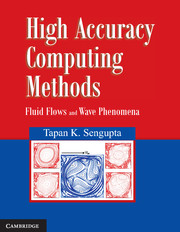Book contents
- Frontmatter
- Contents
- Foreward
- Preface
- Chapter 1 Basic Ideas of Scientific Computing
- Chapter 2 Governing Equations in Fluid Mechanics
- Chapter 3 Classification of Quasi-Linear Partial Differential Equations
- Chapter 4 Waves and Space–Time Dependence in Computing
- Chapter 5 Spatial and Temporal Discretizations of Partial Differential Equations
- Chapter 6 Solution Methods for Parabolic Partial Differential Equations
- Chapter 7 Solution Methods for Elliptic Partial Differential Equations
- Chapter 8 Solution of Hyperbolic PDEs: Signal and Error Propagation
- Chapter 9 Curvilinear Coordinate and Grid Generation
- Chapter 10 Spectral Analysis of Numerical Schemes and Aliasing Error
- Chapter 11 Higher Accuracy Methods
- Chapter 12 Introduction to Finite Volume and Finite Element Methods
- Chapter 13 Solution of Navier–Stokes Equation
- Chapter 14 Recent Developments in Discrete Finite Difference Computing
- Exercises
- References
- Index
Chapter 2 - Governing Equations in Fluid Mechanics
Published online by Cambridge University Press: 05 January 2014
- Frontmatter
- Contents
- Foreward
- Preface
- Chapter 1 Basic Ideas of Scientific Computing
- Chapter 2 Governing Equations in Fluid Mechanics
- Chapter 3 Classification of Quasi-Linear Partial Differential Equations
- Chapter 4 Waves and Space–Time Dependence in Computing
- Chapter 5 Spatial and Temporal Discretizations of Partial Differential Equations
- Chapter 6 Solution Methods for Parabolic Partial Differential Equations
- Chapter 7 Solution Methods for Elliptic Partial Differential Equations
- Chapter 8 Solution of Hyperbolic PDEs: Signal and Error Propagation
- Chapter 9 Curvilinear Coordinate and Grid Generation
- Chapter 10 Spectral Analysis of Numerical Schemes and Aliasing Error
- Chapter 11 Higher Accuracy Methods
- Chapter 12 Introduction to Finite Volume and Finite Element Methods
- Chapter 13 Solution of Navier–Stokes Equation
- Chapter 14 Recent Developments in Discrete Finite Difference Computing
- Exercises
- References
- Index
Summary
Introduction
A beginner in the field of computing is hardly aware of the importance of formulations responsible for the accuracy in scientific computing. In theoretical fluid mechanics it is not important as to which form of Navier–Stokes equation is solved. But, in computing this is paramount, and there is always ongoing debate among practitioners about the superiority of different formulations and numerical methods employed by different schools of thought.
Governing differential equations are obtained by considering a control volume and balancing fluxes of quantities of interest, obtained in the limit of vanishing size of the control volume. This provides a point-by-point description of intrinsic properties of interest. In many methods of computing, this point description of conservation principle is integrated over a finite control volume. Obtaining governing differential equation is described in this way here, for the conservation of mass, momentum and energy. This is followed by discussion on desirability of casting differential equations in conservation form, which is found to be impervious to details of discretization to a great extent, as compared to non-conservation form.
Here, we also note that often one requires to investigate the problem by formulating the governing equation in non-inertial frame. Readers will have no difficulty in appreciating the need for it in weather forecasting. It is also appropriate and convenient for many engineering flows, where one part of the body is in relative motion with respect to other parts, as in problems of aeroelasticity. This is also needed for rigid bodies of arbitrary shape executing time-dependent motion.
- Type
- Chapter
- Information
- High Accuracy Computing MethodsFluid Flows and Wave Phenomena, pp. 8 - 30Publisher: Cambridge University PressPrint publication year: 2013



